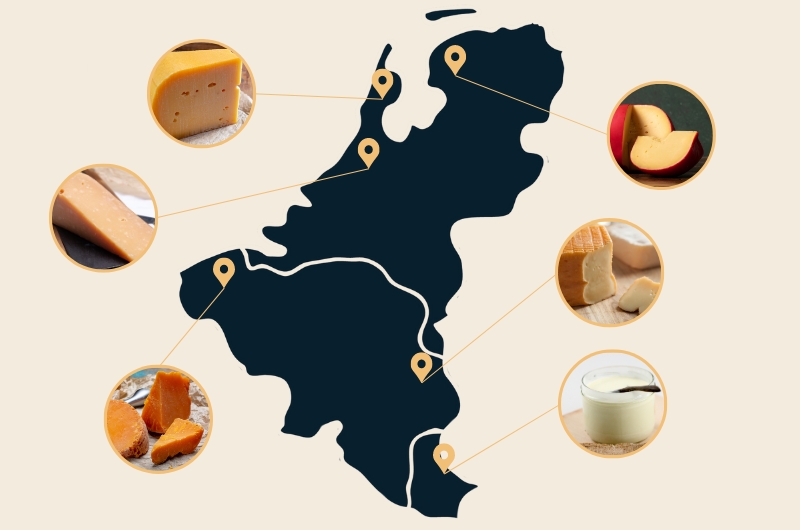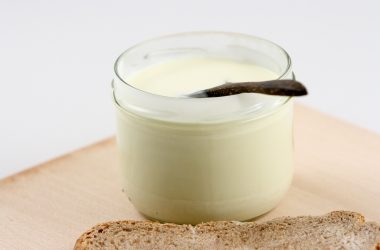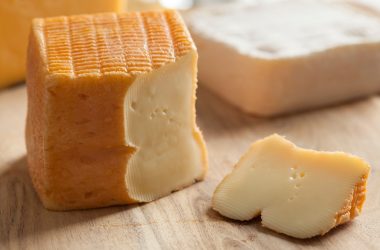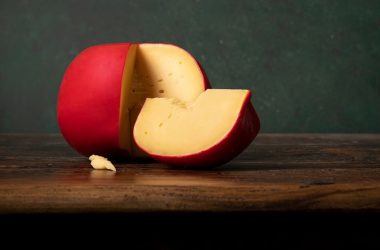A Tour of Benelux Cheese

Benelux Cheese is world-renowned. This is due to the good ‘cow land’ that the Low Countries offer to grazing cattle. These cows ancestors were brought over by the Vikings and now produce some outstanding milk which is made into favourites like Edam and Gouda.
Cancoillotte
As we’re coming from Germany, our first stop on our Benelux tour is Luxembourg, one of the world’s smallest countries but with many food delicacies. Their national cheese is Cancoillotte, a runny cheese made from French Metton cheese. The Metton cheese is melted over a small flame with a little water or milk, salt and butter. The result is a sticky, oozy cheese that is served in glass pots and usually smeared on an open sandwich with mustard. It’s history dates back to the 16th century with records showing that it was made in the village of Oyrieres. It is acidic and buttery, with a strong fermented smell, like a tiny fondue.

Limburger/Rommedoe/Herve
Originating in the area once known as the Duchy of Limburg, Limburger has different names depending on the country it is now made in. In Belgium it’s more commonly known as Herve cheese, and in Netherlands it’s called ‘Rommedoe’, German’s know it as ‘Limburger’.
The Dutch version ‘Rommedoe’ comes from the word Roum, which is the Limburg dialect word for cream. Doe is derived from the French doux, or soft. The cheese is indeed super creamy and semi-soft, depending on its level of maturity. The Belgians like their Limburger ‘ripe’ where it begins to soften up and can be spread on a sandwich. It can also be sliced when it’s at a springy stage.
We mentioned Limburger in our German tour, and how culturally famous it is, appearing in Monty Python and Looney Toons sketches. This is because it’s a famously stinky cheese, which comes from its rind. It’s so stinky in fact that they use it in mosquito traps in Africa, as it smells so similar to the smell of human feet.
Herve is the Belgian version, made In the Herve countryside and stored in cheese cellars to mature. Herve is the PDO protected name and classed as the original.

Mimolette / Flandrien Rouge
Staying in Belgium, we head to West Flanders to sample a Flemish version of the French Mimolette. Known locally a Flandrien Rouge, it has carrot juice or carotene added to the milk giving it a distinctive red colour. This adds to the flavour too, offering a balance of fruitiness and nuttiness. The cheese is matured for six to twelve months after which time the colour darkens to deep orange, and the texture becomes hard, granular and brittle.
The cheese is similar to parmesan in many ways – the caramelly flavours, the hard rind and sharp, developing flavour. It can be used in the same way as Parmesan is – sprinkled on top of pasta, adding flavour to doughs or creating cheese sauces.
In the Netherlands, the cheese is known as Commissiekaas.

Gouda
Heading north to Netherlands, we find ourselves in Gouda, home of an extremely famous Dutch cheese that is loved all over the world. The first mention of Gouda cheese dates from 1184, making it the oldest recorded cheese in the world still produced today with the same recipe. The cheese is named after the city of Gouda in southern Holland not because it was produced in or around that city, but because it was traded there.
The market square would be a bustle of activity, with cheese-porters carrying huge 16kg cheeses to buyers, who negotiated a price using a ritual bargaining system where buyers and sellers would clap each others hands and shout out prices.
Cheesemaking was actually a woman’s task in Dutch culture, passed down through the generations through the line of the daughter. Today, some farmers still use traditional methods to produce ‘Boerenkaas’ or Farmer’s Cheese, which is a PDO form of Gouda using unpasteurised milk.
Gouda is known for its fudgy, nutty flavours, springy texture and yellow protective wax. The maturity of the cheeses produces a wide variety of finishes, from mild and creamy through to sharp and malty. At full maturity it can develop small crystals and be quite crumbly.

Edam
In North Holland we find another extremely well-known Dutch cheese, Edam. It’s perhaps most famous for its appearance, as it always has a bright red rind made from paraffin wax, and a half-sphere cut. You would be forgiven for thinking that a Babybel is an Edam, but it’s actually classed as an ‘Edam-like’ cheese. Real Edam is creamy, tangy and slightly nutty. It’s milder than Gouda, but both are made using similar methods with pasteurised cow’s milk, whilst Gouda’s milk is whole, Edam’s is part-skimmed. It’s this essential difference that changes the fat percentage and allows the saltier, nutty flavours to come through in Edam.
Edam also matures well and hardens, instead of spoiling, for an extended time. These qualities made it the most popular cheese in the world between the 14th and 18th centuries, on boats at sea and across the world in remote Dutch colonies.

Beemster
The final stop in our Benelux cheese tour is just a few miles from the North Sea, is Beemster. The area is the first Polter in the Netherlands, a below-sea-level area that was reclaimed from a lake using windmills to extract the water. This left behind a sea clay that has created fertile lands for the Dutch cattle – both cows and goats. It produces famously rich and creamy milk.
In typical Dutch style, Beemster is a semi-hard, waxed round cheese. The difference between Gouda and Edam comes from the milk source, which is unique to Beemster, and the fact that the cheeses are ripened in changing conditions. The production is still mostly done by hand using traditional, time-tested recipes.
The Beemster milk co-operative is the exclusive provider of milk to Ben & Jerry’s in Europe.
The cheese varies greatly depending on the level of maturity, from mellow, creamy and fresh through to rich, complex and bursting with flavour.













